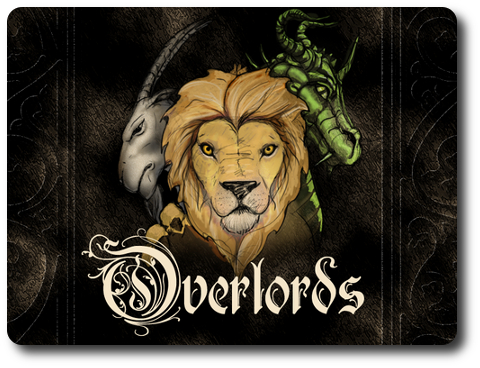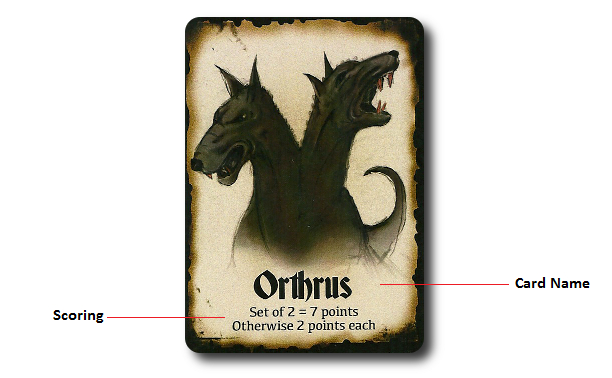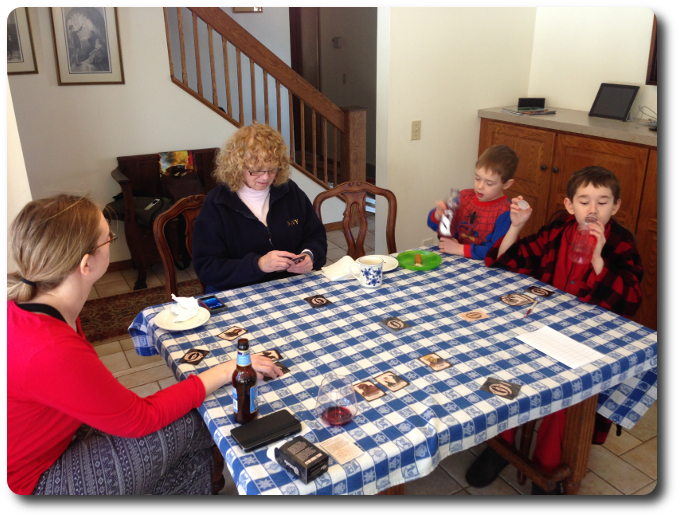
The Basics:
- For ages 9 and up (publisher suggests 12+)
- For 2 to 4 players
- Approximately 20 minutes to complete
Geek Skills:
- Active Listening & Communication
- Counting & Math
- Logical & Critical Decision Making
- Reading
- Strategy & Tactics
- Hand/Resource Management
Learning Curve:
- Child – Easy
- Adult – Easy
Theme & Narrative:
- Gather your forces to become the ultimate overlord!
Endorsements:
- Gamer Geek mixed!
- Parent Geek approved!
- Child Geek mixed!
Overview
Again and again, the dark forces were beaten back by the Champions of Light. Sulking in their shadowy domains after their most recent defeat, they bickered among themselves. Each blamed the other for their consistent failure to conquer the lands. One Dark Lord believed the problem was lack of leadership and recommended that a new leader, an Overlord, be chosen. All agreed, but who should lead?
Overlords, a self-published game designed by Bill Paterno via the Game Crafter, is comprised of 68 Monster cards, 14 Hired Hand cards, 7 Reference cards, and 1 Overlord card. Not included with the game, but necessary to play, is a pen or pencil and a piece of paper to record players’ scores. The cards are durable and are as thick as your standard playing card. The artwork by Jorge Pimentel compliments the game’s theme very well. It’s worth noting that this game was a finalist in the Micro Game Challenge hosted by the Game Crafter and sponsored by All Us Geeks and Father Geek.
Game Set Up
To set up the game, first find and separate the Overlord, Reference, and Hired Hand cards from the Monster cards. Place the Reference and Overlord cards to one side for now.
Second, shuffle and randomly deal 7 of the Hired Hand cards or select 7 and place them with the Monster cards. The remaining 7 Hired Hand cards are not used and should be returned to the game box.
Third, shuffle the Monster and selected Hired Hand cards together and deal out to each player a set number of cards. The number of cards dealt is determined by the number of players. Players should look at their cards, but keep them hidden from their opponents until played. Place the remaining deck of cards face-down in the middle of the playing area.
Fourth, hand the Overlord card to one player and place the Reference cards to one side for easy viewing.
This completes the game set up. Time to create your army!
Overlording for Fun and Profit
Overlords is played in hands and rounds. All players play simultaneously. The number of hands and rounds is determined by the number of players in the game.
During a single hand, each player selects 1 Monster card or 1 Hire Hand card (NOT both) from their current hand and plays it.
Monster cards are played face-up in front of the player in a single pile (referred to as the player’s “Army Pile”) with each new Monster card being placed on the top of the previously played Monster card. This is referred to as “Recruiting”. Players cannot look through their Army Pile and must remember which cards they have played in the past. This is very important to game scoring.

Hired Hands are played face-up to the side of the player. This is referred to as “Hiring”. Hired Hands are special cards that give the player a new action. Only 1 Hired Hand card can be activated per turn by the player and only those Hired Hands that were played in a previously turn can be activated.

Hired Hands are activated BEFORE a player recruits a Monster card or hires a Hired Hand card. Once activated, the action is resolved and the player now continues their turn. Hired Hands include:
- Knights (3 different versions; Black, Red, and Blue): Knights allow the player to recruit additional cards, look through any Army Pile, or exchange cards from the draw deck.
- Thief: The Thief allows the player to grab another player’s top-most card from their Army Pile.
- Sorcerer: The Sorcerer forces players to pass the top-most card on each player’s Army Pile.
- Medusa: The Medusa forces a player’s opponents to play cards from their hand at random as their recruitment or hire.
- Lich King: The Lich King allows a player to swap their hand of cards with an opponent or force opponents to swap hands before they recruit or hire.
Note: The Overlord card is used to determine the sequence of effects triggered by Hired Hands. All Hired Hand effects start with the player who currently has the Overlord card and continues clockwise.
Once all the players have activated a Hired Hand (optional), played a Monster or Hired Hand card, the remaining cards in the player’s hand are passed, face-down, to the opponent on the player’s left. The Overlord card is never played, but is passed with the hand. Players now complete the above steps as described above using the cards that were passed to them.
Ending the Hand
The hand ends when all the cards have been played. Players now organize their Army Piles by Monster type. Each Monster card type has specific rules for scoring. For example, the “Cyclops” Monster card will award the player 6 points if only 1 is in their Army pile, but is only worth 2 points if the player has more than 1. Each Hired Hand card the player has is worth 2 points.
Once all the scores are calculated, they are recorded and added to any previous hand scores. All the cards are now gathered up EXCEPT for any Hired Hand cards that were activated during the very last turn. These stay with the player. Shuffle the deck and deal the cards. A new hand now begins.
Ending the Game
At the end of the final round, all the points are calculated and the player with the most points wins the game. They are now the new Overlord and will lead the dark forces to victory!
Game Variants
2-Player Game
If only playing with 2-players, the game set up and game play is the same, except a “dummy hand” is dealt and used. The dummy hand is part of the rotation of cards, but only players can use the cards in it. Players take turns controlling the dummy hand.
Versus
This game variant allows two teams of two players each to compete against each other. Team members should sit opposite of each other and a single game is only 2 rounds long. Team members may exchange 1 card with each other before they take their turn for the round, but not the Overlord card. At the end of the first round when points are scored, individual players swap their Army Piles with their team member and add to them during the next round. When the game ends, team members add their points together. The team with the most points wins the game.
To learn more about Overlords, visit the game’s web page on the Game Crafter.
Prediction
I am always impressed and amused by how many different ways we can play games using cards. Pagat.com, a website dedicated to hosting traditional card game rules for two or more players, has more than 1000 card games listed. That’s a lot, but the author of the site admits that the list is far from complete. There are many card games that use cards other than the standard variety. For example, Dominion is very popular, as is Magic: The Gathering. There are even games that use special decks of cards that were designed to be the basis for new game designs. For example, The Decktet game system.
I have no doubt that every player in our three groups will have no problems learning and playing Overlords. The card game’s rules are easy to grasp and the game play would appear to be fairly brisk. My only concern is the initial learning curve that comes with understanding how each card is scored. When I looked at the cards, the scoring rules made perfect sense to me. When I passed the game to my 9-year-old, he couldn’t understand some of the scoring rules.
When playing Overlords, you really need to know how each card is scored in order to play well. Failure to do so will result in the player collecting cards that provide little value. But none of the cards hurt, either. There is no “Old Maid”, so to speak. This means that any player can score points, even if they don’t understand the game or consistently get a bad pass when the cards are handed to them.
Another element is at work here that I am excited to try. The Hired Hand cards allow players to slightly disrupt the hand by taking special actions. Individually, the Hired Hand cards are not that interesting, but the advantage they give to the player could mean the difference between winning the hand or not. I like that because none of the Hired Hand cards are potential game breakers, but each can give a player a slight edge. They also give the player two points, regardless if they are used or not.
Teaching Overlords is best done with a practice hand. Make sure you explain the different ways the cards are scored. The scoring rules found at the bottom of each Monster card are not always clear to new players, but their format is easy enough to teach to. A brief explanation is all that should be required. Note that players do need to know how to read to play the game, as there are a number of cards that have special rules for scoring the player needs to be able to read and understand without giving anything away.
And so, after I taught Overlords to my oldest little geek, I asked him his thoughts on the game so far.
“Easy rules and cool looking monsters! Let’s play!” ~ Liam (age 9)
My little geek is ready to take the title of Overlord! Let’s play and see if he can claim that which he seeks…
Final Word
Please Note: The following review comments are based off the initial release of Overlords. The game and cards described above are slightly different from the game our players enjoyed.
The Child Geeks were excited to play Overlords, but their level of excitement began to slip as the game was played. Some of the Child Geeks lost interest while others became engrossed in the hand management and memory aspects of the game. From what we observed, a Child Geek enjoyed the game if they liked card games that required some thought to play well. If the Child Geek didn’t like card games where a good memory was a prerequisite, Overlords bombed. This was interesting, as I didn’t see Overlords as a complicated game until the Child Geeks started to lose track of what they played and what their opponents’ played. If you don’t keep track of your own Army Pile, you won’t know which cards to play. If you don’t keep track of your opponents’ Army Pile, you won’t know how best to utilize the Hired Hand cards. The end result was a mixed endorsement from the Child Geeks. The older and more experienced the player, the more they enjoyed the game.

Nothing better than feuding for dark power with fiends and family…
The Parent Geeks were not sure what to think when I introduced the game. According to one Parent Geek, “What the hell is an Orthus?” A few of the Parent Geeks thought Overlords was a fantasy fighting card game. There were even a few who thought it was a collectible card game. All it took was a quick explanation of the rules, and every Parent Geek was onboard to play, even if they weren’t well versed in Greek mythology. By far, the best players were the non-gamers and the Parent Geeks who played a lot of card games. They quickly grasped the game’s concept and how to maximize points. I am also pretty sure a number of players were counting cards. One of the neat aspects of Overlords is that each hand is different because you only use a very small number of cards in the deck. You only need to focus on the hand, which frees up a player’s mind to concentrate on a small set of cards. After a couple of hands, one Parent Geek said, “This is a great example of a simple card game that has a lot of flavor. I really like it.” All the Parent Geeks agreed and voted to approve it. The only aspect of the game they didn’t care for was the scoring, which seemed to take a long time and only improved a little as the game continued.
The Gamer Geeks, like the Child Geeks, were mixed. Some of the Gamer Geeks thought Overlords was a good example of how you could make a simple card game into something worth a Gamer Geek’s time. According to one Gamer Geek who thought so, “What I like about this game is its simplicity and depth. You have to play smart and keep track of your cards to be competitive.” All the Gamer Geeks agreed, more or less, but not fully. A number of the Gamer Geeks found the game to be boring or only so-so. According to one of those Gamer Geeks, “All I am doing is passing cards, playing a card, and passing cards over and over again. At the end, I’m rewarded with a longer than necessary scoring session.” The Gamer Geeks agreed to disagree.
Overall, I am very pleased with this fantasy themed card drafting/set collection game. I found the 2-player game variant to be a bit clunky, but only when put up against the smooth and entertaining game play that comes with 3 and 4 players. But I don’t count this as a game design flaw, per se. Rather, I see it as a clear indication that the game was intended to play with more than just one friend. The Versus game variant is entertaining and great for evenings when you have another couple over.
I agree with my fellow game players regarding the game’s scoring, but do not consider it a detractor. When I played with adults who knew how to play the game, scores were counted quickly and recorded. When I played the game with new players and Child Geeks, the scoring sessions became a bit painful. Each time the hand ended, we would go through each player’s Army Pile and count their points. Up until every player felt comfortable counting their own points, the game’s momentum came to an abrupt halt as we calculated scores. That was a bit jarring and left a number of players with a bad taste in their mouth. Which, based on our observations, would appear to be the main reason why some players just didn’t care for Overlords.
Overlords is challenging, but only when you play it against a strong player. There is nothing intrinsically complicated about the game, which makes it easy to teach and to play. When playing against better players, you have to start memorizing cards and what was played by opponents. That’s where we lost some of the Child Geeks, but gained full approval from the Parent Geeks and half the Gamer Geeks. And while I would consider Overlords to be an entertaining and well-thought-out game, it doesn’t have enough depth or engagement for some of our most elitist of players. Do check the game out if you’re in the mood for a thematic casual card game where you need to think to compete, but not burn your brain in the process of doing so.
This game was given to Father Geek as a review copy. Father Geek was not paid, bribed, wined, dined, or threatened in vain hopes of influencing this review. Such is the statuesque and legendary integrity of Father Geek.




Cyrus,
Thanks so much for taking time out of your schedule to review Overlords. I am happy with the overall thoughts of your group. I do agree that adding up points can feel a bit daunting for beginners. I tried to find a balance between having a variety of scoring but still keeping it simple. I even experimented cutting the point values in half but it threw off the balance a bit. Do you feel a companion scoring app would be helpful? I have been working on one during my spare time but it’s not quite ready for prime time.
The only other question I had was if anyone struggled or was frustrated with the memory aspect. I can imagine that perhaps some of the younger children might have been. I usually am not a fan of memory mechanisms in games but I feel like it works really well in Overlords. Otherwise, if all the information was out in the open, it becomes more of a math game.
Thanks again for the review!
Bill
Thanks for the game, Bill!
The scoring in Overlords is not bad, but felt out of place. The majority of the game is easy to grasp, easy to play, and quick. The scoring is none of these things, but only for beginners and Child Geeks. If an application was available to help me count scores, I wouldn’t use or recommend it. Knowing how the game is scored is very important to the game itself, regardless of how long it might take.
The only people who struggled with the memory aspect were the younger Child Geeks. Parent Geeks and Gamer Geeks sometimes forgot what cards they played at first, but the memory aspect of game play never felt burdensome to the majority.